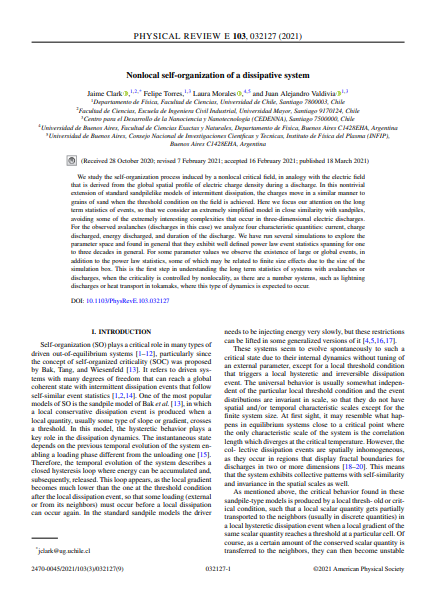Nonlocal self-organization of a dissipative system

Fecha
2021-01-01Autor
Torres, Felipe
Morales, Laura
Valdivia, Juan
Clark, Jaime [Univ Mayor, Fac Ciencias, Escuela Ingn Civil Ind, Chile]
Ubicación geográfica
Notas
HERRAMIENTAS
Acceda a títulos restringidos
¿Cómo descargar?Resumen
We study the self-organization process induced by a nonlocal critical field, in analogy with the electric field that is derived from the global spatial profile of electric charge density during a discharge. In this nontrivial extension of standard sandpilelike models of intermittent dissipation, the charges move in a similar manner to grains of sand when the threshold condition on the field is achieved. Here we focus our attention on the long term statistics of events, so that we consider an extremely simplified model in close similarity with sandpiles, avoiding some of the extremely interesting complexities that occur in three-dimensional electric discharges. For the observed avalanches (discharges in this case) we analyze four characteristic quantities: current, charge discharged, energy discharged, and duration of the discharge. We have run several simulations to explore the parameter space and found in general that they exhibit well defined power law event statistics spanning for one to three decades in general. For some parameter values we observe the existence of large or global events, in addition to the power law statistics, some of which may be related to finite size effects due to the size of the simulation box. This is the first step in understanding the long term statistics of systems with avalanches or discharges, when the criticality is controlled by nonlocality, as there are a number systems, such as lightning discharges or heat transport in tokamaks, where this type of dynamics is expected to occur.
URI
https://repositorio.umayor.cl/xmlui/handle/sibum/9099https://journals.aps.org/pre/abstract/10.1103/PhysRevE.103.032127
https://doi.org/10.1103/PhysRevE.103.032127
Coleccion/es a la/s que pertenece:
Si usted es autor(a) de este documento y NO desea que su publicación tenga acceso público en este repositorio, por favor complete el formulario aquí.